Attached files
| file | filename |
|---|---|
| 8-K - CURRENT REPORT ON FORM 8-K - PEPCO HOLDINGS LLC | jan10-phi8k.htm |
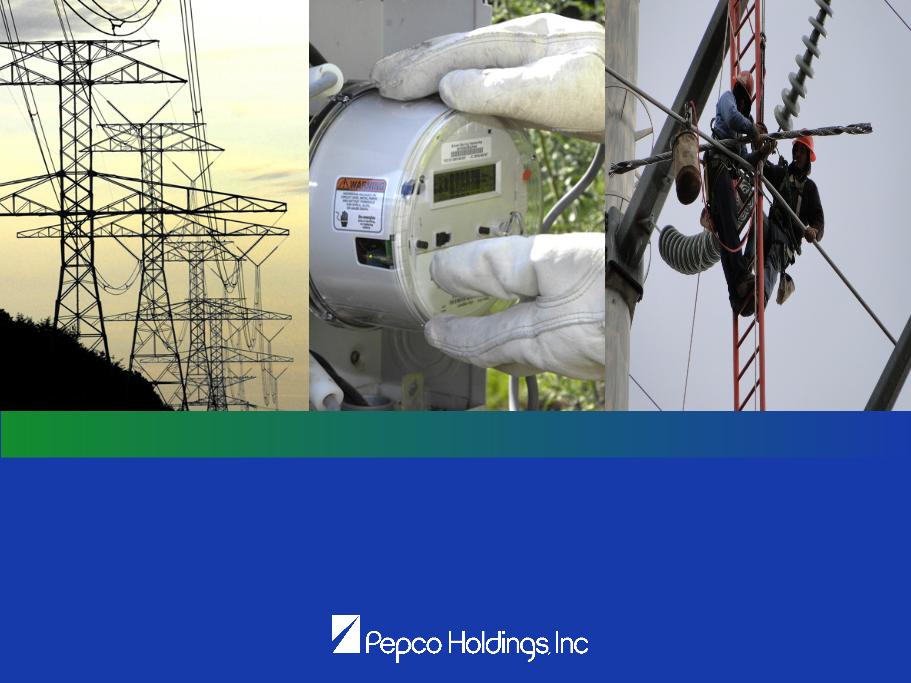
Williams Capital Group Transmission Seminar
William Gausman
Senior Vice President, Strategic Initiatives
NEW YORK, NY • JANUARY 11, 2012

1
Safe Harbor Statement
Some of the statements contained in today’s presentation with respect to Pepco Holdings, Pepco, Delmarva Power and Atlantic City Electric, and each of their respective
subsidiaries, are forward-looking statements within the meaning of the U.S. federal securities laws and are subject to the safe harbor created thereby and by the Private
Securities Litigation Reform Act of 1995. These statements include declarations regarding each reporting company’s intents, beliefs and current expectations. You can
generally identify forward-looking statements by terminology such as “may,” “might,” “will,” “should,” “could,” “expects,” “intends,” “assumes,” “seeks to,” “plans,” “anticipates,”
“believes,” “projects,” “estimates,” “predicts,” “potential,” “future,” “goal,” “objective,” or “continue”, the negative or other variations of such terms, or comparable terminology,
or by discussions of strategy that involve risks and uncertainties. Forward-looking statements involve estimates, assumptions, known and unknown risks, uncertainties and
other factors that may cause one or more reporting company’s actual results, levels of activity, performance or achievements to be materially different from any future results,
levels of activity, performance or achievements expressed or implied by such forward-looking statements. Therefore, forward-looking statements are not guarantees or
assurances of future performance, and actual results could differ materially from those indicated by the forward-looking statements. These forward-looking statements are
qualified in their entirety by, and should be read together with, the risk factors included in the “Risk Factors” section of each reporting company’s annual and quarterly reports
filed in 2011, and investors should refer to these risk factor sections. The forward-looking statements contained herein are also qualified in their entirety by reference to, and
should be read together with, the following important factors, which are difficult to predict, contain uncertainties, are beyond each reporting company’s control and may cause
actual results to differ materially from those contained in forward-looking statements: demonstrating compliance with applicable regulatory requirements, including regulatory
orders; fines, penalties or other sanctions which may be assessed by regulatory authorities against Pepco Holdings’ regulated utilities in the future; potential outcomes of
pending and future rate cases, including the possible disallowance of costs and expenses; the amount of expenditures necessary to comply with regulatory requirements,
including regulatory orders, and to implement reliability enhancement, emergency response and customer service improvement programs; changes in prevailing
governmental policies and regulatory actions affecting the energy industry, including allowed rates of return, industry and rate structure, acquisition and disposal of assets
and facilities, operation and construction of transmission and distribution facilities, and the recovery of purchased power expenses; weather conditions affecting usage and
emergency restoration costs; population growth rates and changes in demographic patterns; changes in customer energy demand due to conservation measures and the
use of more energy-efficient products; general economic conditions, including the impact of an economic downturn or recession on energy usage; changes in and
compliance with environmental and safety laws and policies; changes in tax rates or policies or in rates of inflation; changes in accounting standards or practices; changes in
project costs; unanticipated changes in operating expenses and capital expenditures; the ability to obtain funding in the capital markets on favorable terms; rules and
regulations imposed by, and decisions of, Federal and/or state regulatory commissions, PJM, the North American Electric Reliability Corporation and other applicable electric
reliability organizations; legal and administrative proceedings (whether civil or criminal) and settlements that influence each reporting company’s business and profitability;
pace of entry into new markets; volatility in customer demand for electricity and natural gas; interest rate fluctuations and the impact of credit and capital market conditions on
the ability of a reporting company to obtain funding on favorable terms; and effects of geopolitical events, including the threat of domestic terrorism or cyber attacks. Any
forward-looking statements speak only as to the date of this presentation and each reporting company undertakes no obligation to update any forward-looking statements to
reflect events or circumstances after the date on which such statements are made or to reflect the occurrence of unanticipated events. New factors emerge from time to time,
and it is not possible for a reporting company to predict all such factors, nor can any reporting company assess the impact of any such factor on such reporting company’s
business or the extent to which any factor, or combination of factors, may cause results to differ materially from those contained in any forward-looking statement. The
foregoing factors should not be construed as exhaustive.
subsidiaries, are forward-looking statements within the meaning of the U.S. federal securities laws and are subject to the safe harbor created thereby and by the Private
Securities Litigation Reform Act of 1995. These statements include declarations regarding each reporting company’s intents, beliefs and current expectations. You can
generally identify forward-looking statements by terminology such as “may,” “might,” “will,” “should,” “could,” “expects,” “intends,” “assumes,” “seeks to,” “plans,” “anticipates,”
“believes,” “projects,” “estimates,” “predicts,” “potential,” “future,” “goal,” “objective,” or “continue”, the negative or other variations of such terms, or comparable terminology,
or by discussions of strategy that involve risks and uncertainties. Forward-looking statements involve estimates, assumptions, known and unknown risks, uncertainties and
other factors that may cause one or more reporting company’s actual results, levels of activity, performance or achievements to be materially different from any future results,
levels of activity, performance or achievements expressed or implied by such forward-looking statements. Therefore, forward-looking statements are not guarantees or
assurances of future performance, and actual results could differ materially from those indicated by the forward-looking statements. These forward-looking statements are
qualified in their entirety by, and should be read together with, the risk factors included in the “Risk Factors” section of each reporting company’s annual and quarterly reports
filed in 2011, and investors should refer to these risk factor sections. The forward-looking statements contained herein are also qualified in their entirety by reference to, and
should be read together with, the following important factors, which are difficult to predict, contain uncertainties, are beyond each reporting company’s control and may cause
actual results to differ materially from those contained in forward-looking statements: demonstrating compliance with applicable regulatory requirements, including regulatory
orders; fines, penalties or other sanctions which may be assessed by regulatory authorities against Pepco Holdings’ regulated utilities in the future; potential outcomes of
pending and future rate cases, including the possible disallowance of costs and expenses; the amount of expenditures necessary to comply with regulatory requirements,
including regulatory orders, and to implement reliability enhancement, emergency response and customer service improvement programs; changes in prevailing
governmental policies and regulatory actions affecting the energy industry, including allowed rates of return, industry and rate structure, acquisition and disposal of assets
and facilities, operation and construction of transmission and distribution facilities, and the recovery of purchased power expenses; weather conditions affecting usage and
emergency restoration costs; population growth rates and changes in demographic patterns; changes in customer energy demand due to conservation measures and the
use of more energy-efficient products; general economic conditions, including the impact of an economic downturn or recession on energy usage; changes in and
compliance with environmental and safety laws and policies; changes in tax rates or policies or in rates of inflation; changes in accounting standards or practices; changes in
project costs; unanticipated changes in operating expenses and capital expenditures; the ability to obtain funding in the capital markets on favorable terms; rules and
regulations imposed by, and decisions of, Federal and/or state regulatory commissions, PJM, the North American Electric Reliability Corporation and other applicable electric
reliability organizations; legal and administrative proceedings (whether civil or criminal) and settlements that influence each reporting company’s business and profitability;
pace of entry into new markets; volatility in customer demand for electricity and natural gas; interest rate fluctuations and the impact of credit and capital market conditions on
the ability of a reporting company to obtain funding on favorable terms; and effects of geopolitical events, including the threat of domestic terrorism or cyber attacks. Any
forward-looking statements speak only as to the date of this presentation and each reporting company undertakes no obligation to update any forward-looking statements to
reflect events or circumstances after the date on which such statements are made or to reflect the occurrence of unanticipated events. New factors emerge from time to time,
and it is not possible for a reporting company to predict all such factors, nor can any reporting company assess the impact of any such factor on such reporting company’s
business or the extent to which any factor, or combination of factors, may cause results to differ materially from those contained in any forward-looking statement. The
foregoing factors should not be construed as exhaustive.
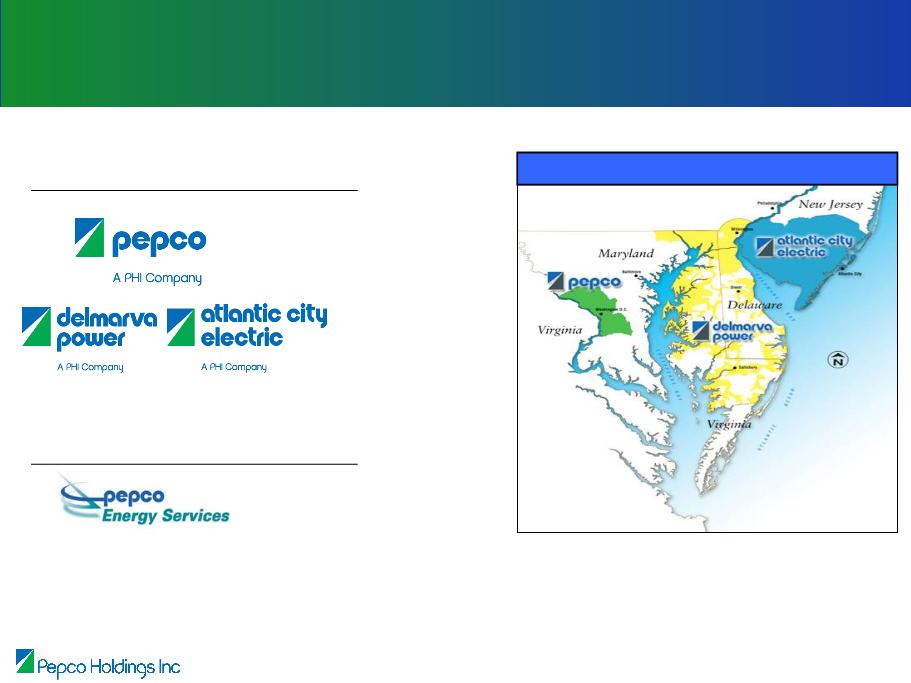
2
Power Delivery
Energy Services
Our Businesses
PHI Service Territory
Forecast
Business Mix*
Business Mix*
90 - 95%
5 - 10%
* Percentages based on projected operating income for 2011 - 2015
Note: See Safe Harbor Statement at the beginning of today’s presentation.

Diverse, Stable Service Territory
Regulatory Diversity, 2010 Rate Base
3
Residential
37%
Commercial
47%
Government
10%
Industrial
6%
Customer Diversity, 2010 MWh Sales
Diversified customer base and more stable employment trends help
to minimize recessionary impacts on our service territory
to minimize recessionary impacts on our service territory
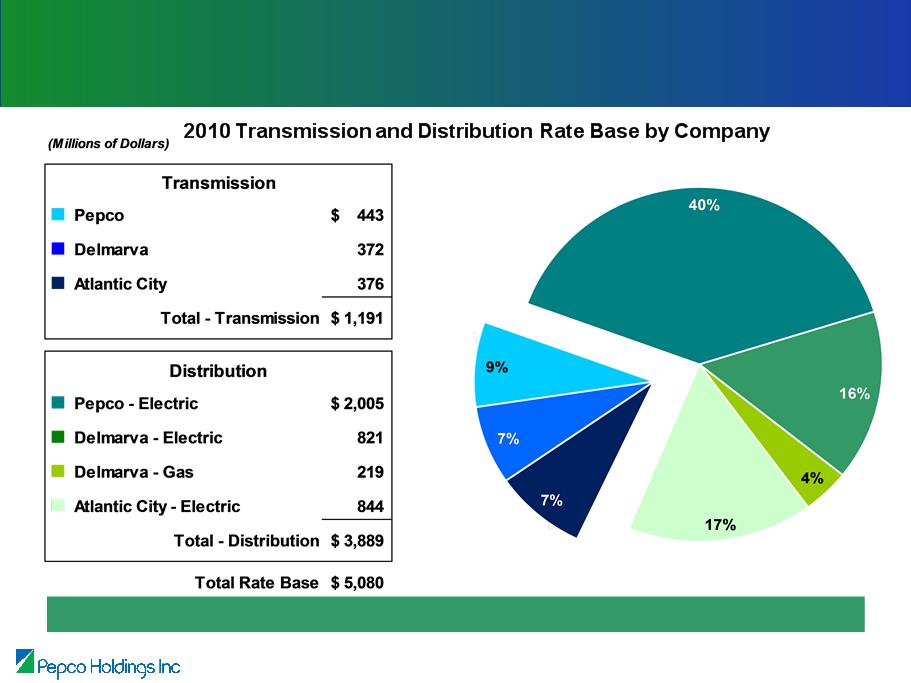
Rate Base Summary
Distribution is 77% and Transmission is 23% of our 2010 year-end rate base
Note: See Safe Harbor Statement at the beginning of today’s presentation.
4

5
Capital Expenditures - 2012 - 2016 Forecast
Note: See Safe Harbor Statement at the beginning of today’s presentation.
(1) Assumes Mid-Atlantic Power Pathway (MAPP) in-service date of 2020.
(2) Reflects the remaining anticipated reimbursement pursuant to awards from the U.S. DOE under the ARRA.
Distribution is 72% and Transmission is 28% of Power Delivery
Capital Expenditures forecasted over the next five years
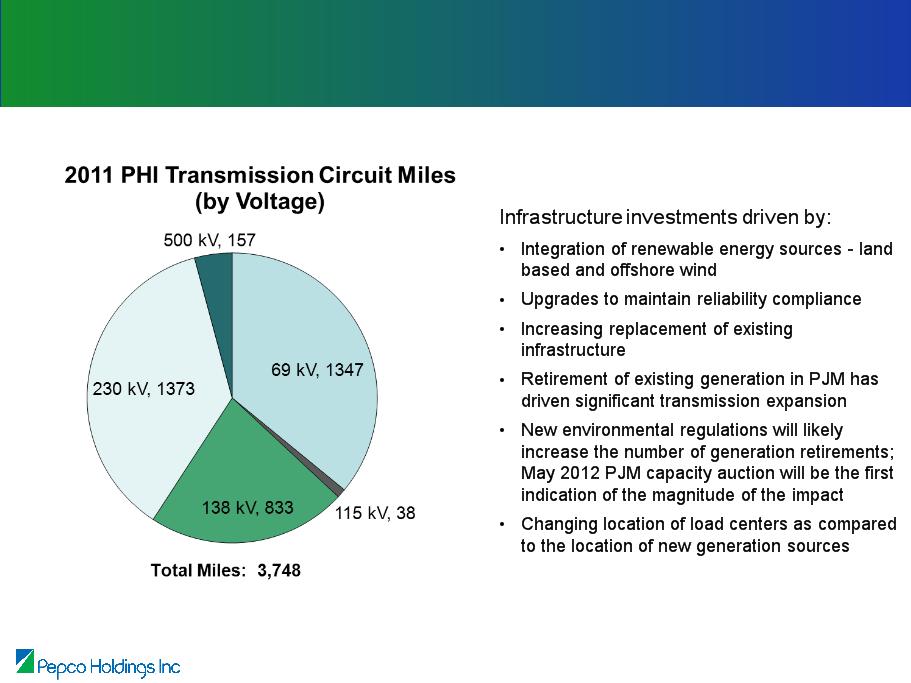
6
Transmission Overview
Note: See Safe Harbor Statement at the beginning of today’s presentation.
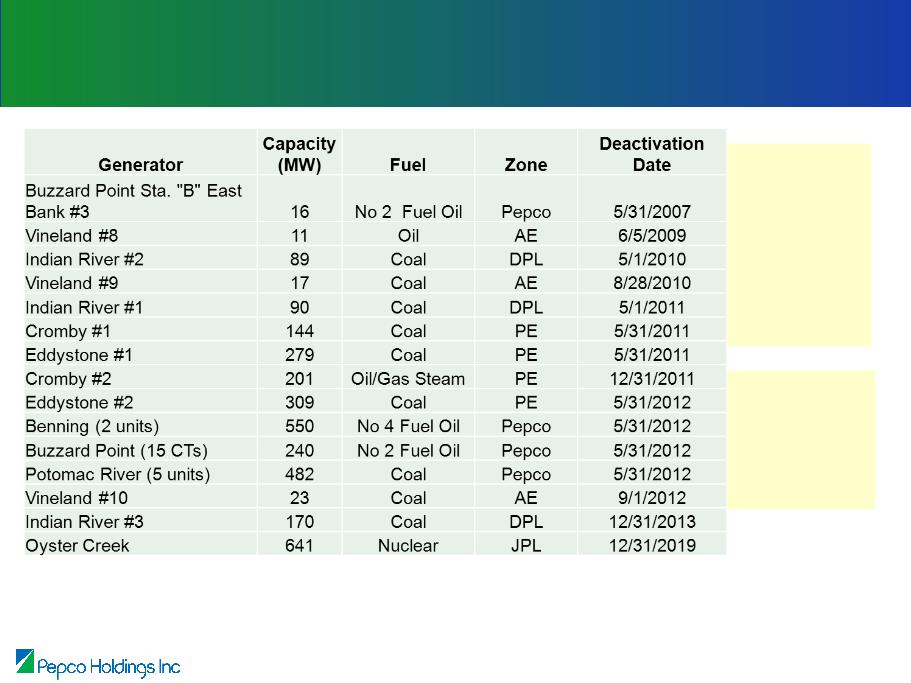
Generation Deactivations
Source:
http://www.exeloncorp.com/powerplants/oystercreek/Pages/profile.aspx
http://www.pjm.com/planning/generation-retirements.aspx
http://www.pjm.com/documents/reports/eia-reports.aspx
Approximately
847 MW of
generation
within the PHI
footprint and
surrounding
area have been
retired in the
last 5 years
847 MW of
generation
within the PHI
footprint and
surrounding
area have been
retired in the
last 5 years
Approximately
2415 MW have
announced
future
deactivation
dates
2415 MW have
announced
future
deactivation
dates
7
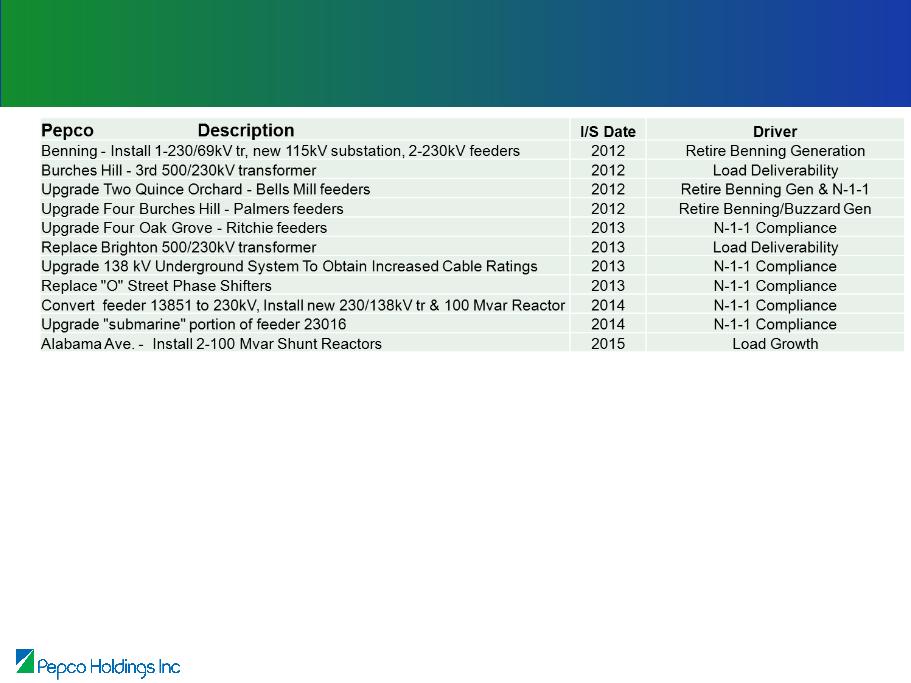
Need for Transmission Enhancements
• Need for new transmission lines is not primarily driven by load growth
• NERC reliability requirements have added new operating requirements and, as a result,
are a significant driver for new transmission facilities across all three operating
companies
are a significant driver for new transmission facilities across all three operating
companies
• Generation retirement can occur with very little advanced notice and much faster than
the Company can build new transmission lines - PJM planning process being revised
the Company can build new transmission lines - PJM planning process being revised
• Since load growth is not driving the need, replacement of existing facilities is generally
the preferred solution as opposed to constructing new lines
the preferred solution as opposed to constructing new lines
• Increased load forecast can accelerate the upgrades to maintain N-1-1 NERC
compliance
compliance
8
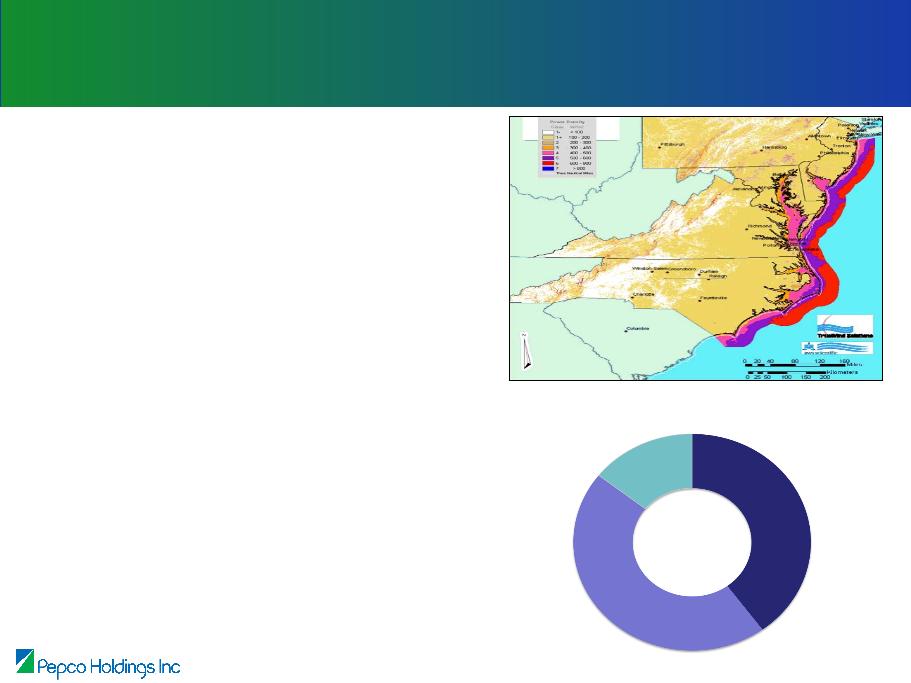
Integrating Renewable Resources into the PHI System
• The PHI service territory offers a unique
opportunity with one of the greatest
concentrations of strong off-shore wind
resources existing along the Mid-Atlantic
region
opportunity with one of the greatest
concentrations of strong off-shore wind
resources existing along the Mid-Atlantic
region
• In order to develop large scale off-shore wind
projects, additional transmission
infrastructure will be needed as existing
transmission systems were designed to
deliver energy in only one direction to the
coastal service territory of PHI and not from
off-shore wind generators
projects, additional transmission
infrastructure will be needed as existing
transmission systems were designed to
deliver energy in only one direction to the
coastal service territory of PHI and not from
off-shore wind generators
• Solar integration can impact the transmission
system by its variable nature during peak
load conditions
system by its variable nature during peak
load conditions
• Variable resources present new dimensions
into transmission planning and will require
new solutions - high speed switching with
Static Var Compensator (SVC) and High
Voltage Direct Current (HVDC) systems
into transmission planning and will require
new solutions - high speed switching with
Static Var Compensator (SVC) and High
Voltage Direct Current (HVDC) systems
• A strong transmission system and advanced
system monitoring are needed to be able to
operate with high concentrations of variable
resources
system monitoring are needed to be able to
operate with high concentrations of variable
resources
PSEG
367 MW
JCPL
1,164
MW
ACE
1,017
MW
New Jersey Utilities: Solar Projects In PJM Queue
As of April 19th 2011
9

Need For Advanced Technologies
• The transmission systems of the future will incorporate advanced
technologies to control flow, manage voltage variations and improve
monitoring for operations and maintenance requirements
technologies to control flow, manage voltage variations and improve
monitoring for operations and maintenance requirements
• PHI is incorporating these technologies into the systems we are
building today:
building today:
– Installing our fifth SVC
– Utilizing HVDC for the MAPP project
– Installing high temperature conductors
– PHI identified four Phasor Monitoring Units (PMU) locations, and two
Phasor Data Concentrators (PDC) locations
Phasor Data Concentrators (PDC) locations
– Installing 99 Dissolved Gas Analysis (DGA) monitors on substation
transformers
transformers
10
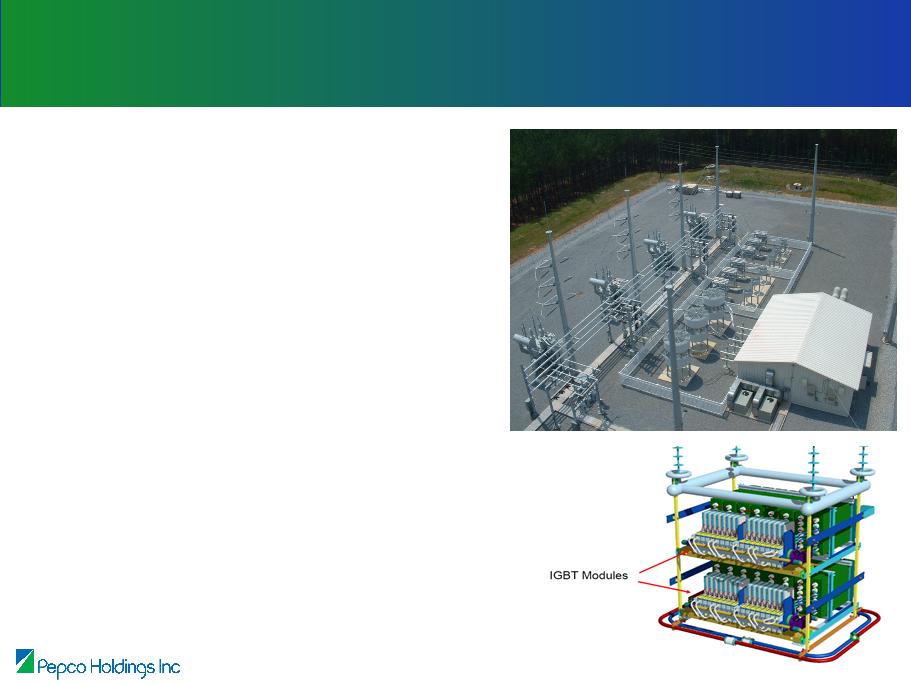
Benefits of New Technologies
SVCs and HVDC
• High speed switching to
respond to changing
conditions on the transmission
system
respond to changing
conditions on the transmission
system
• Increases grid voltage by
supplying reactive power
supplying reactive power
• Decreases grid voltage by
consuming reactive power
consuming reactive power
• Control flows on the system
• HVDC can provide black start
and Bi-directional operation
that are needed to support
renewable resources
and Bi-directional operation
that are needed to support
renewable resources
11
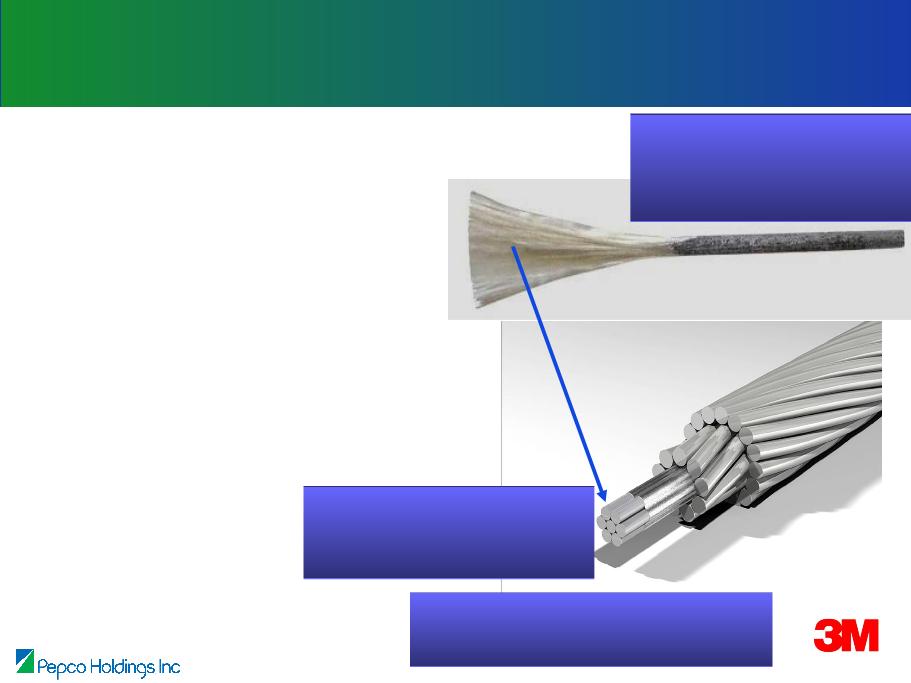
High Temp Al
-Zr
240° C
-Zr
240° C
Composite
Core Wires
Core Wires
Aluminum
Tape
Tape
Aluminum
Oxide
Fibers
Oxide
Fibers
Aluminum
Matrix
Composite
Core Wire
Matrix
Composite
Core Wire
• Stable, compatible materials,
even at high temperatures
even at high temperatures
• Construction similar to ACSR with >2
times the ampacity
times the ampacity
• Rated at 210°C continuous
operation and 240°C
emergency
operation and 240°C
emergency
© 3M 2011. All rights reserved.
Aluminum Conductor Composite Reinforced (ACCR)
Benefits of New Technologies
• Less sag at high temperatures - maintain or
improve clearances at high energy levels
improve clearances at high energy levels
• Higher strength-to-weight ratio - maintain or
improve stress on structures
improve stress on structures
• Twice the ampacity on existing structures,
while matching tensions, clearances
while matching tensions, clearances
• Reduced time to permit and environmental
impacts
impacts
• Utilize existing structures without
modifications
modifications
12

Benefits of New Technologies
• Measurements of voltages and
currents, which are time-tagged with
high precision via GPS time signal
receivers
currents, which are time-tagged with
high precision via GPS time signal
receivers
• Operators can make better control
decisions
decisions
• Enhanced post-disturbance analysis
• Continuous asset monitoring
improves reliability and increases
cost effectiveness of maintenance
improves reliability and increases
cost effectiveness of maintenance
• Broad dissemination of asset health
• An easy-to-use human interface for
monitoring prevents data overload
and unnecessary time spent trying
to identify a problem
monitoring prevents data overload
and unnecessary time spent trying
to identify a problem
Phasor Monitoring Units and Dissolved Gas Analysis
13
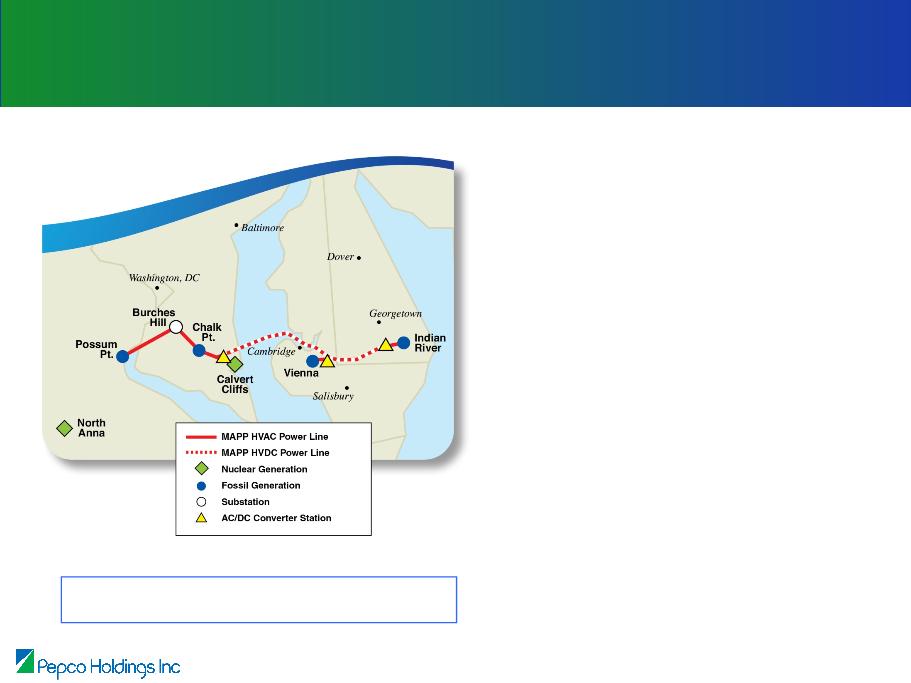
14
• PJM provided notice to PHI in August
2011 that the MAPP project in-service
date will be delayed until 2019 - 2021
2011 that the MAPP project in-service
date will be delayed until 2019 - 2021
• PHI suspended most permitting,
engineering, and environmental
studies
engineering, and environmental
studies
• Maryland PSC approved our request to
delay the procedural schedule for one
year or until PJM has issued its 2012
Regional Transmission Expansion
Plan
delay the procedural schedule for one
year or until PJM has issued its 2012
Regional Transmission Expansion
Plan
• PHI plans to spend approximately $5
million in 2012 to complete right-of-way
acquisition in Dorchester County and
some permitting and environmental
activities
million in 2012 to complete right-of-way
acquisition in Dorchester County and
some permitting and environmental
activities
Mid-Atlantic Power Pathway - Project Update
FERC Approved ROE: 12.8%
2020 in-service date currently planned
Note: See Safe Harbor Statement at the beginning of today’s presentation.

15
PHI - Positioned for Growth
• $5.6 billion in planned infrastructure investment over 5 years, with 28% in
transmission
transmission
• Significant transmission growth to support generation retirements and NERC
policy compliance
policy compliance
• Timely transmission cost recovery by FERC formula and incentive rates
• Reasonable regulatory outlook - ongoing distribution rate cases focused on
timely cost recovery
timely cost recovery
• PHI focused on continued improvement in operating performance - safety,
customer satisfaction, reliability, cost
customer satisfaction, reliability, cost
Note: See Safe Harbor Statement at the beginning of today’s presentation.
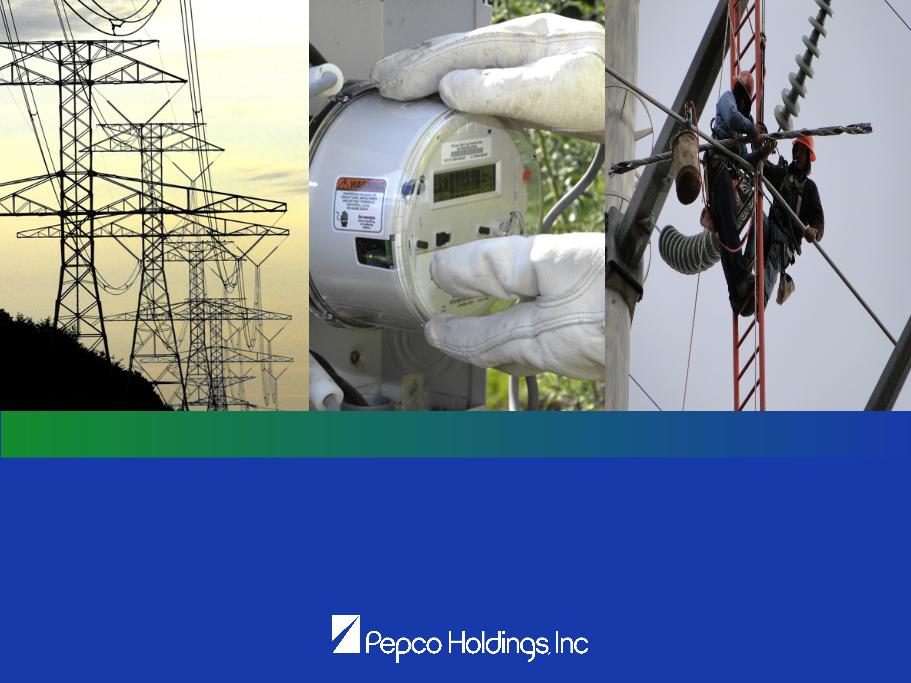
Williams Capital Group Transmission Seminar
William Gausman
Senior Vice President, Strategic Initiatives
NEW YORK, NY • JANUARY 11, 2012

Appendix
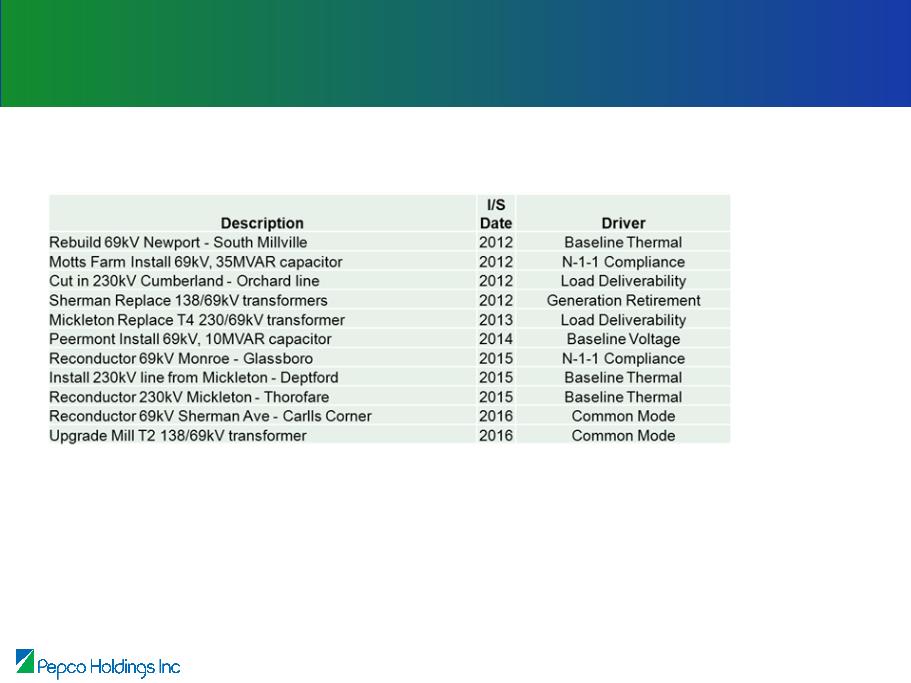
Transmission Projects 2012 - 2016
ACE
Notes:
1.Common Mode outages include line faults associated with stuck breaker, double circuit tower line, and
faulted circuit breakers and buses
faulted circuit breakers and buses
2.N-1-1 outages ensure facilities can be operated within normal thermal and voltage limits after N-1 (single)
contingency assuming re-dispatch and system adjustments and within emergency thermal ratings and voltage
limits after an additional single contingency (N-1-1)
contingency assuming re-dispatch and system adjustments and within emergency thermal ratings and voltage
limits after an additional single contingency (N-1-1)
Note: See Safe Harbor Statement at the beginning of today’s presentation.
18
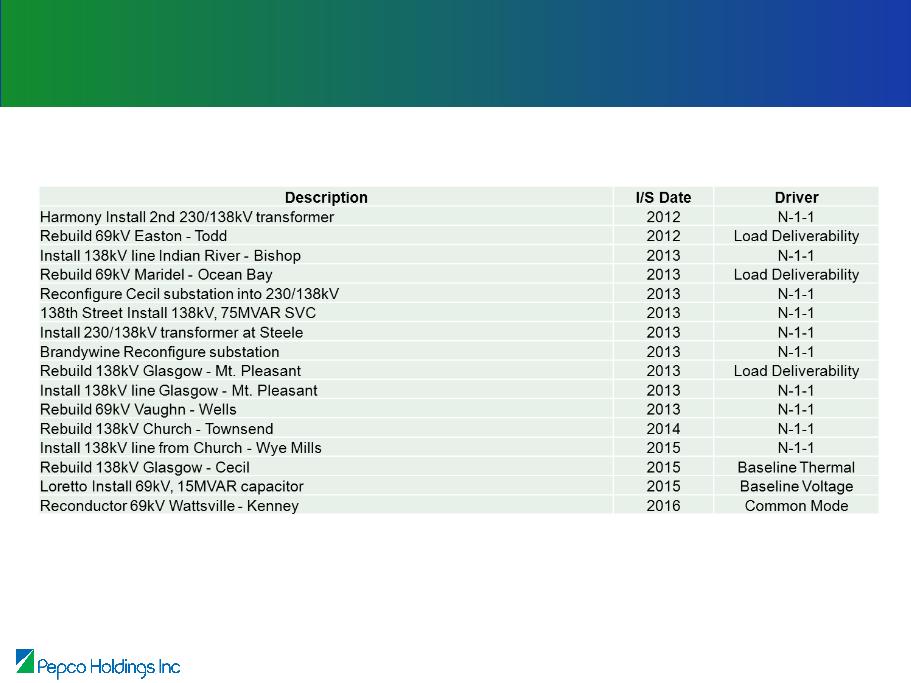
Transmission Projects 2012 - 2016
DPL
Note: See Safe Harbor Statement at the beginning of today’s presentation.
19
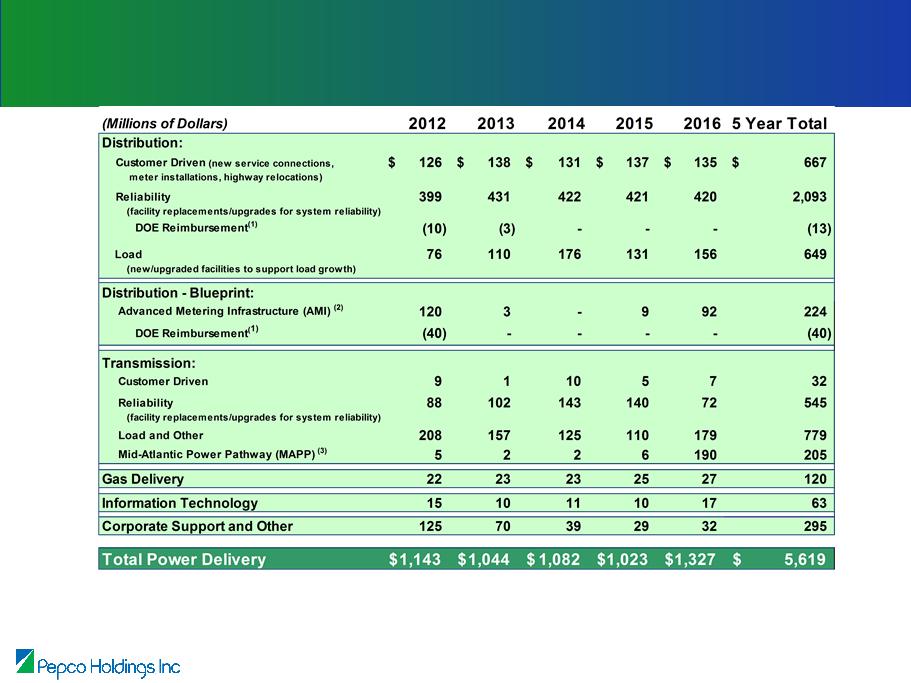
20
Capital Expenditures Forecast -
Updated November 2011
Updated November 2011
Note: See Safe Harbor Statement at the beginning of today’s presentation.
(1) Reflects the remaining anticipated reimbursement pursuant to awards from the U.S. DOE under the ARRA.
(2) Installation of AMI in New Jersey is contingent on regulatory approval ($9 million in 2015, $92 million in
2016).
2016).
(3) Assumes MAPP in-service date of 2020.
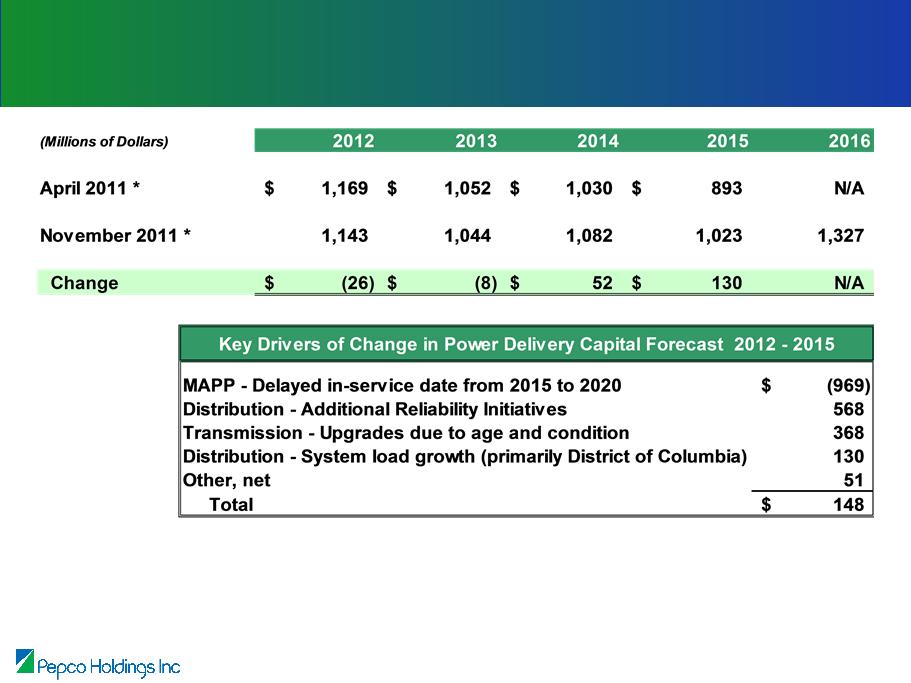
21
Forecast Capital Expenditures Comparison
* Amounts are net of anticipated reimbursement pursuant to awards from the U.S. DOE under the ARRA.
Note: See Safe Harbor Statement at the beginning of today’s presentation.

Distribution Rate Cases - Pending
Pepco - District of Columbia
Pepco - District of Columbia
Regulatory lag mitigation measures proposed:
• Reliability Investment Recovery Mechanism (RIM)
• Fully forecasted test years
Drivers of requested increase:
•Rate base growth/reliability investments
•Investment in Advanced Metering Infrastructure (AMI)
•Increase in authorized ROE
(1) Current filed position as of October 29, 2011
(2) Office of People’s Counsel
22

23
Note: See Safe Harbor Statement at the beginning of today’s presentation.
Distribution Rate Cases - Pending
Atlantic City Electric - New Jersey
Atlantic City Electric - New Jersey
Drivers of requested increase:
• Rate base growth/reliability investments
Regulatory lag mitigation measure proposed in a separate filing made October 18, 2011:
• Request the continuance and expansion of the recently completed Infrastructure Investment Program (IIP)
• Allows recovery of non-revenue generating infrastructure investment through a special rate outside of a base
rate filing
rate filing
• Under the IIP, Atlantic City Electric proposes to recover reliability-related capital expenditures of $63 million, $94
million and $81 million, in 2012, 2013 and 2014, respectively
million and $81 million, in 2012, 2013 and 2014, respectively

24
Distribution Rate Cases - Pending
Delmarva Power - Delaware Electric
Delmarva Power - Delaware Electric
Note: See Safe Harbor Statement at the beginning of today’s presentation.
Drivers of requested increase:
• Rate base growth/reliability investments
• Increase in operating expenses
Two regulatory lag mitigation measures proposed
in filing:
in filing:
•Reliability Investment Recovery Mechanism - provides full
and timely recovery of future capital investments related to
distribution system reliability
and timely recovery of future capital investments related to
distribution system reliability
•Fully forecasted test periods

25
Distribution Rate Cases - Pending
Delmarva Power - Maryland
Delmarva Power - Maryland
Note: See Safe Harbor Statement at the beginning of today’s presentation.
Drivers of requested increase:
• Rate base growth/reliability investments
• Recovery of Hurricane Irene restoration
expenses
expenses
• Customer service enhancements
• Increase in authorized ROE
Regulatory lag mitigation measures proposed in
filing:
filing:
•Reliability Investment Recovery Mechanism (RIM)
• Fully forecasted test years

26
Distribution Rate Cases - Pending
Pepco - Maryland
Pepco - Maryland
Note: See Safe Harbor Statement at the beginning of today’s presentation.
Drivers of requested increase:
• Rate base growth/reliability investments
• Recovery of Hurricane Irene restoration
expenses
expenses
• Customer service enhancements
• Increase in authorized ROE
Regulatory lag mitigation measures proposed in
filing:
filing:
•Reliability Investment Recovery Mechanism (RIM)
•Fully forecasted test years

27
• Filing Cycle Status
– Pepco DC Pending - Filed July 2011
– Atlantic City Electric NJ Pending - Filed August 2011
– Delmarva Power DE - Electric Pending - Filed December 2011
– Delmarva Power MD Pending - Filed December 2011
– Pepco MD Pending - Filed December 2011
– Delmarva Power DE - Gas Filing targeted for 1Q2013
• Rate cases will be filed in 2012 if progress to reduce regulatory lag is less than
satisfactory in the current cycle of base rate cases
satisfactory in the current cycle of base rate cases
Distribution Rate Cases - The Current Cycle
Note: See Safe Harbor Statement at the beginning of today’s presentation.

28
Pepco - Maryland
Reliability Case 9240
Reliability Case 9240
• Related to power outages caused by severe weather in Pepco’s service
territory in 2010
territory in 2010
• Public Service Commission initiated the proceeding for Pepco in August 2010
to investigate the reliability of the electric distribution system and the quality of
service provided to customers
to investigate the reliability of the electric distribution system and the quality of
service provided to customers
• Reliability Enhancement Plan submitted to the Commission in August 2010
• Commission decision rendered December 21, 2011
– Imposed $1 million fine on Pepco
– Requires the filing of a detailed five-year work plan and periodic status reports
– Pepco must demonstrate improvement in reliability to recover reliability costs
• Pepco’s position
– Focused on the implementation of the Reliability Enhancement Plan
– No plan to appeal fine
– Reliability costs are being prudently incurred and should be recovered

29
Reliability Standards - Maryland
• Following working group process and rule making hearings, Commission approved draft
rules establishing requirements for:
rules establishing requirements for:
– Service interruption duration and frequency standards
– Service restoration
– Poorest performing feeder and device activation standards
– Downed wire response
– Customer communications
– Vegetation management
– Equipment inspection
– Major Outage Event Plan
• First measurement period begins as soon as the regulations are adopted (expected to be
no later than July 1, 2012)
no later than July 1, 2012)
Maryland (PSC - RM43) - Rule making proceeding applying to all electric utilities in the state to
establish comprehensive reliability and service standards
establish comprehensive reliability and service standards

30
Reliability Standards - District of Columbia
• New rules require improvement in reliability performance (outage frequency and duration) on
an annual basis beginning in 2013 and continuing through 2020
an annual basis beginning in 2013 and continuing through 2020
• Pepco filed an application for reconsideration of the regulations with the Commission in
August 2011 stating:
August 2011 stating:
– Regulations were flawed because they proposed an inconsistent method to calculate reliability
– Standards may not be realistically achievable at an acceptable level of cost over the longer term
• Revision to rules proposed by Commission in December 2011 to address certain issues
raised in Pepco’s application for reconsideration:
raised in Pepco’s application for reconsideration:
– Method to calculate reliability was revised to a manner reflecting District of Columbia-only data
– After June 2015, Pepco is permitted to petition the Commission to re-evaluate reliability standards
for 2017-2020 to address feasibility and cost issues
for 2017-2020 to address feasibility and cost issues
District of Columbia - New reliability standards adopted in July 2011, further technical
revisions proposed December 2011
revisions proposed December 2011

31
• Equity investment as of September 30, 2011 of $1.3 billion
• Annual tax benefits of $52 million
• Annual net earnings of $21 million
• Current Status:
– IRS audit settlement approved in November 2010 for the 2001/2002 periods;
disallowed net losses on the cross-border energy leases
disallowed net losses on the cross-border energy leases
– Paid $74 million of taxes, $1 million of penalties and $28 million of interest associated
with the 2001/2002 audit in 2011
with the 2001/2002 audit in 2011
– Filed a claim for refund of tax payment, interest and penalties with the IRS in July 2011
– Since the claim for refund was not approved by the IRS within the statutory six-month
period, complaints will be filed in the U.S. Court of Federal Claims against the IRS in
January 2012 to resolve the issue and recover the tax payment, interest and penalties
period, complaints will be filed in the U.S. Court of Federal Claims against the IRS in
January 2012 to resolve the issue and recover the tax payment, interest and penalties
– Absent a settlement, litigation will likely take several years to resolve
Cross-Border Energy Lease Status
Note: See Safe Harbor Statement at the beginning of today’s presentation.
